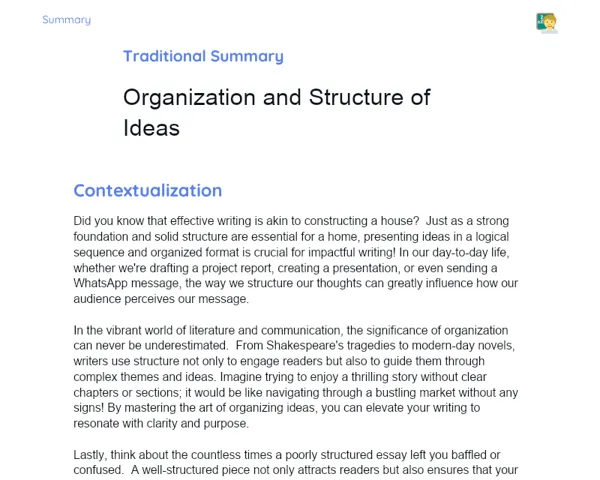Socioemotional Summary Conclusion
Goals
1. 🎯 Understand how possessive pronouns and the genitive case differ in English.
2. ✍️ Use possessive pronouns and the genitive case in sentences to clearly indicate ownership.
3. 🧠 Build socio-emotional skills like self-control and effective communication while discussing possession.
Contextualization
🌟 Have you ever thought about the joy of sharing your favorite things in English? Imagine how it feels when you say 'my book' or 'John's dog'. Possessive pronouns and the genitive case go beyond simple grammar rules; they’re essential tools for expressing our identities and values. Let’s unravel these concepts together and enhance the clarity and emotional depth of your communication!
Exercising Your Knowledge
Possessive Pronouns
Possessive pronouns show that something belongs to someone without repeating the noun. They enhance clear communication, especially where repetition can be cumbersome. Examples include 'mine', 'yours', 'his', 'hers', 'ours', and 'theirs'.
-
🔑 Indication of Possession: They take the place of the possessed noun to prevent repetition. Example: 'That book is mine.'
-
🌍 Universal Use: Crucial for any ownership context, from physical items to emotions. Example: 'Your idea is brilliant.'
-
🗣️ Communication Practice: Implementing possessive pronouns refines your communication skills, promoting clarity and brevity in speech and writing.
Possessive Adjectives
Possessive adjectives precede nouns to show ownership. They ensure that listeners or readers know immediately who the noun belongs to, leading to direct and precise communication. Examples include 'my', 'your', 'his', 'her', 'our', and 'their.'
-
🔍 Clarity in Expression: They appear before the noun, clearly indicating ownership. Example: 'This is my car.'
-
👥 Personal Connection: They help create a personal bond between the speaker and the object, highlighting feelings of ownership. Example: 'Her smile is beautiful.'
-
🔗 Grammatical Consistency: They promote flow in writing and speaking, avoiding confusion. Example: 'Our team is the best.'
Saxon Genitive
The Saxon genitive indicates possession by adding 's' to the end of the possessor or just an apostrophe (') for plural possessors ending in 's'. This structure is often used to express ownership directly and is commonly seen in reference to people or animals.
-
👑 Direct Indication of Possession: It brings clarity and conciseness to expressing ownership. Example: 'Anna's book.'
-
🐾 Common Use in Personal Relationships: It’s often used for things belonging to people or animals, helping clarify responsibilities and feelings. Example: 'The dog's leash.'
-
📖 Ease of Learning: With its simple, repetitive structure, it is easy to learn and apply, aiding in retention for students.
Key Terms
-
Possessive Pronouns: Pronouns that signify ownership, substituting the possessed noun.
-
Possessive Adjectives: Adjectives indicating ownership, typically used before a noun.
-
Saxon Genitive: A possessive form that adds 's' to the possessor or an apostrophe (') if the possessor is plural and ends with 's'.
For Reflection
-
🤔 Reflection 1: How does the idea of 'possession' shape our relationships and daily exchanges? Write about a moment when ownership meant something significant to you.
-
💬 Reflection 2: How can using possessive pronouns and the Saxon genitive help you express your emotions more effectively in day-to-day conversations?
-
🔄 Reflection 3: Recall a frustrating experience while learning about possession in English. What strategies did you employ or wish you had used to manage those feelings?
Important Conclusions
-
📚 Possessive pronouns, possessive adjectives, and the Saxon genitive are vital for expressing ownership in English.
-
💡 These grammatical aspects not only clarify communication but also facilitate emotional expression, helping us convey feelings of belonging and duty.
-
🌐 Mastering these forms of possession is a key skill for effective communication across diverse everyday situations and cultural settings.
Impacts on Society
Possessive pronouns and the Saxon genitive significantly influence our everyday interactions. Picture being able to effortlessly say 'my book' or 'John's ball' in English. This enhances clarity, reducing misunderstandings, and bolsters our social skills, allowing us to express belonging and accountability effectively.
Furthermore, using these concepts accurately increases empathy and understanding during conversations. When we can precisely articulate our possessions and feelings, we're better positioned to comprehend and respond to others' emotions. This fosters a healthier and more respectful communication atmosphere, essential for both academic excellence and balanced personal and professional relationships.
Dealing with Emotions
To handle your emotions while learning possessive pronouns and the Saxon genitive, try the RULER method: 1️⃣ Recognize any feelings that arise during challenging moments, such as frustration or happiness. 2️⃣ Understand the reasons behind these emotions, like a recurring mistake or a breakthrough. 3️⃣ Name these emotions correctly, labeling them as frustration, joy, etc. 4️⃣ Express your emotions appropriately, whether in discussions with peers, teachers, or in writing. 5️⃣ Regulate your emotions using strategies like deep breathing or brief pauses during your study sessions. This practice will help you manage your feelings better while improving your academic performance.
Study Tips
-
📝 Create Daily Sentences: Use possessive pronouns and the Saxon genitive to describe the objects and emotions in your life. This will reinforce your learning through practice.
-
📖 Active Reading: When reading English texts, underline all instances of possession. Take notes on these sentences and try crafting your own.
-
👥 Practice in Groups: Form study circles and create dialogues incorporating forms of possession. This makes learning more engaging and interactive.


